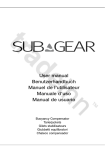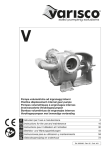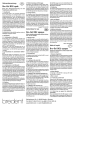Download Betriebsanleitung Dubliergerät EDG 1
Transcript
Betriebsanleitung Dubliergerät EDG 1 REF 61760 (230 V) Bitte lesen Sie die Betriebsanleitung aufmerksam, bevor Sie mit dem Gerät arbeiten! Bewahren Sie die Betriebsanleitung zum späteren Gebrauch an einem sicheren Ort auf! Wichtige Information Warnung Deutsche Anleitung: Seite 1 - 14 English version: Page 15 – 27 61760V02-2010-07 Seite / Page 1 von / of 28 Inhaltsverzeichnis 1 Allgemeines 3 2 Sicherheitshinweise 3 2.1 Bestimmungsgemäße Verwendung 2.2 Risiken und Gefahren 3 3 3 5 3.1 3.2 3.3 3.4 3.5 4 4.1 4.2 4.3 4.4 4.5 Installation Lieferumfang Leistungsmerkmale Merkmale EU-Version Merkmale US-Version Aufstellung / Lagerbedingungen 5 5 5 5 5 Bedienung 6 Vor Inbetriebnahme Inbetriebnahme und Einstellung der Temperatureinheit Befüllen des Gerätes Starten des Gerätes Programmierung / Bedeutung der Tasten 6 6 7 7 8 5 Wartung und Pflege 6 Garantie 11 7 Problembehandlung 11 8 Service / Kundendienst 13 61760V02-2010-07 9 Seite / Page 2 von / of 28 1 Allgemeines Das Dubliergerät egger EDG 1 wurde zum Schmelzen und Bevorraten von Dubliermassen entwickelt. Das egger EDG 1 ist ein leistungsfähiges, kompaktes Dubliergerät mit einem starken Rührwerk, automatischer Erfassung der Schmelzzyklen und möglicher Timerfunktion. Die Füllung des Gerätes kann beliebig zwischen 2 kg und 5 kg je nach Bedarf variiert werden. Ein Mikrokontroller mit 3 Temperaturfühlern steuert alle Funktionen des Gerätes. Schnelles schonendes Aufheizen, rasches Rückkühlen und Konstanthalten der Dubliermasse. Das Gerät ist einfach zu bedienen und wartungsfreundlich. 2 Sicherheitshinweise 2.1 Bestimmungsgemäße Verwendung Das Dubliergerät EDG1 dient zur Aufbereitung von Dubliermassen im otoplastischen Labor. Es ist für alle gelartigen Dubliermassen, die aufgeschmolzen werden, spezifiziert. Die Aufschmelzphase, das Rückkühlen und die konstante Arbeitstemperatur werden über einen Mikroprozessor gesteuert. Bei nicht bestimmungsgemäßer Verwendung erlöschen sämtliche Garantie- und Haftungsansprüche! 2.2 Risiken und Gefahren 1. Das Gerät darf nur an einer schutzgeerdeten Steckdose mit der am Typenschild angegebenen Netzspannung betrieben werden. Alle Sicherheitsregeln im Umgang mit elektrischen Geräten sind einzuhalten. Gerät nur an einem trockenen Arbeitsplatz betreiben und nicht in Flüssigkeiten tauchen. 2. Das Gerät muss ausreichend belüftet werden. Die Ventilationsöffnungen müssen frei zugänglich sein (Abstand mindestens 15 cm). Der Luftstrom des Lüfters muss frei austreten können. Luftstrom nicht auf Personen richten. Das Gerät darf nicht eingebaut werden (Wärmestau). 3. Im Gerät sind, außer den von außen zugänglichen Dichtungen keine Teile, die vom Betreiber gewartet oder eingestellt werden müssen. Das Öffnen des Gerätes darf ausschließlich von fachkundigen Personen durchgeführt werden. Vor dem Öffnen Netzstecker ziehen. Es dürfen nur vom Hersteller zugelassene Originalteile verwendet werden. Eingriffe in das Gerät, insbesondere eigene Reparaturversuche, führen zu Garantieverlust und Haftungsausschluss. 4. Bei Reinigung und Pflege am Gerät, besonders bei Arbeiten im Bereich des Rührwerks muss das Netzkabel abgezogen werden. Das Rührwerk ist geschliffen und sehr kräftig. Schwerwiegende Verletzungen können bei Missachtung dieses Hinweises die Folge sein. 5. Ist das Netzkabel beschädigt, ist dieses komplett auszutauschen, es darf nicht weiter gearbeitet werden. Netzstecker nicht am Netzkabel aus der Steckdose ziehen. 6. Zur Reinigung des Gerätes keine Lösungsmittel verwenden. 61760V02-2010-07 Seite / Page 3 von / of 28 7. Es ist sicherzustellen, dass sachunkundige Personen, insbesondere Kinder, mit dem Gerät nicht in Berührung kommen. Zur Arbeit mit dem Gerät sind ausschließlich Fachkräfte oder von Laborinhaber berechtigte und eingewiesene Personen befugt. Vor der Inbetriebnahme muss der Benutzer die Betriebsanleitung lesen, diese befolgen, und bei eventuellen Unklarheiten beim Hersteller rückfragen. 8. Starten Sie das Gerät nur mit geschlossenem Deckel und geschlossenem Auslasshahn. Eine Deckelsicherung schützt Sie vor Verletzungen durch das Rührwerk. Sollte diese Sicherung versagen (Deckel wird geöffnet und Rührwerk bleibt nicht sofort stehen) muss das Gerät unverzüglich außer Betrieb gesetzt werden und zum Service an den Hersteller gesandt werden. 9. Das Gerät erwärmt sich in der Aufschmelzphase auch an der Oberfläche des Gehäuses. Es besteht bei geschlossenem Deckel keine direkte Verbrennungsgefahr, vermeiden Sie jedoch einen Kontakt. Die Dubliermasse erreicht eine Temperatur von maximal 97 °C, die zu Verbrühungen führen kann. Öffnen Sie deshalb niemals den Auslasshahn bei dieser Temperatur. Werfen Sie keine Dubliermasseklumpen in die heiße Masse, heiße Spritzer könnten Sie verletzen (besonders Augen schützen!). 10. Das Gerät ist mit drei Temperatursicherungen, von denen eine Sicherung unabhängig vom Mikroprozessor arbeitet, ausgestattet. Sollte diese unabhängige Sicherung auslösen, so ist eine weitere Verwendung des Gerätes nicht mehr möglich, es muss zum Hersteller gesandt werden. Versuchen Sie nicht, dieses Sicherungssystem zu überbrücken, es dürfte im normalen Betrieb niemals auslösen. Löst es dennoch aus, liegt ein schwerwiegender Fehler vor, der behoben werden muss, sonst besteht im Extremfall Brandgefahr. 11. Das Gerät ist mit einer Zeitvorwahlschaltung ausgerüstet. Grundsätzlich sollten elektrische Heizgeräte (dazu zählt auch das EDG 1) nicht unbeaufsichtigt betrieben werden. Das Gerät ist mit diversen Sicherheitsschaltungen versehen. Sie benutzen die Zeitvorwahl in jedem Fall auf eigenes Risiko ohne Haftungsanspruch an den Hersteller. Bei einem Stromausfall wird aus Sicherheitsgründen die Zeitvorwahl und die normale Funktion des Gerätes unterbrochen. Wenn sich der Strom wieder einschaltet, befindet sich das Gerät im Standby-Modus, also ohne weitere Funktion. 12. Das Gerät ist mit einem Leerlaufschutz ausgestattet. Sollte versehentlich ein unbefülltes, oder ungenügend gefülltes Gerät gestartet werden, schaltet es sich nach einiger Zeit ab und geht in den Fehlermodus (Anzeige „E” auf dem Display). Dieser Fehler kann nur durch ein Ausschalten und Abkühlen des Gerätes beendet werden. Im Fehlermodus sind alle Funktionen gesperrt. Zur Regelung befinden sich im Gerät drei Temperaturfühler (unabhängig von der Temperatursicherung). Sollte einer dieser Fühler defekt sein, geht das Gerät ebenfalls in den Fehlermodus, kann jedoch nicht mehr zurückgesetzt und gestartet werden. Gerät muss an Hersteller gesendet werden. 13. Transportieren Sie das Gerät vorsichtig und nur im abgekühlten Zustand. Vermeiden Sie Stöße und Schläge. Durch das hohe Gewicht kann es sonst zu Deformationen am Topf kommen. Beachten Sie auch bitte unsere Hinweise zum Transport und Versand unter Punkt 7 dieser Anleitung. 61760V02-2010-07 Seite / Page 4 von / of 28 3 Installation 3.1 Lieferumfang Prüfen Sie alle Teile der Lieferung auf Vollständigkeit und Transportschäden. Fehlende Teile oder Transportschäden bitte sofort Ihrem Händler/Hersteller melden. 1 Gerät 1 Netzkabel 1 Inbusschlüssel für das Rührwerk 1 Betriebsanleitung 3.2 Leistungsmerkmale Schutzklasse 1 (Schutzmaßnahme mit Schutzleiter) Gewicht unbefüllt: Füllmenge: Leistung im Lastbetrieb: Leistung im Standby-Modus: Leistung Heizungen: ca.17,5 kg minimal 2 kg / maximal 5,5 kg 1300 Watt 2,3 Watt 1000 Watt 3.3 Merkmale EU-Version Netzspannung: Netzfrequenz: Sicherung: Anschluss: 230 V +/- 10% 50 Hz 6,3 A träge Netzkabel Schuko 3.4 Merkmale US-Version Netzspannung: Netzfrequenz: Sicherung: Anschluss: 115 V +/- 10% 60 Hz 12,5 A träge Netzkabel USA 3.5 Aufstellung/Lagerbedingungen waagerecht aufstellen trockener Standort feste Unterlage Schutz vor Säuren und Laugen trockene Lagerung bei Zimmertemperatur auf ausreichende Belüftung achten kein Betrieb unter 10 °C 61760V02-2010-07 Seite / Page 5 von / of 28 4 Bedienung 4.1 Vor Inbetriebnahme Das Gerät entspricht dem Stand der Technik und den anerkannten sicherheitstechnischen Regeln, trotzdem können Gefahren entstehen! - Gerät nur in einwandfreiem Zustand und unter Beachtung der Betriebsanleitung betreiben! - Anerkannte Regeln für Arbeitssicherheit beachten! - Verwendung nur durch qualifiziertes Personal! - Gerät auf technisch einwandfreien Zustand überprüfen! 4.2 Inbetriebnahme und Einstellung der Temperatureinheit Verbinden Sie das Gerät mit dem mitgelieferten Netzkabel und einer schutzgeerdeten Steckdose. Der Hauptschalter befindet sich an der Rückseite des Gerätes (neben dem Stecker). Die Voreinstellung für EUGeräte ist „C”, für US Geräte „F”. Nach seiner Betätigung haben Sie 4 Sekunden Zeit die Temperatureinheit zu wählen. Für eine Anzeige in Grad Celsius betätigen Sie die „AB” (Pfeil nach unten) Taste, im Display sehen Sie den Buchstaben „C”. Für eine Anzeige in Grad Fahrenheit drücken Sie die „AUF” (Pfeil nach oben) Taste, im Display sehen Sie den Buchstaben „F”. Nach Ablauf dieser 4 Sekunden hören Sie ein kurzes Signal und das Gerät befindet sich im StandbyModus. Danach ist eine Änderung der Einheit nicht mehr möglich. Die gewählte Einheit bleibt auch nach einem Abschalten des Gerätes gespeichert. Hinweis zur Fahrenheitanzeige: Das Gerät rechnet intern immer mit Grad C und rechnet nach der Formel „Grad C x 1,8 +32” . Dadurch kommt es zu Kommazahlen, die jedoch nicht angezeigt werden können und auf- bzw. abgerundet werden. Ein Beispiel: 50 Grad C = 131,0 Grad F — Anzeige: 131 51 Grad C = 132,8 Grad F — Anzeige: 133 Der Wert 132 wird also niemals angezeigt werden ! 61760V02-2010-07 Seite / Page 6 von / of 28 4.3 Befüllen des Gerätes Öffnen Sie den Deckel des Gerätes, eventuell vorhandenes Kondenswasser streifen Sie an der Topfdichtung ab. Sollte etwas Kondenswasser aus dem Gerätegehäuse kommen, bitte mit einem Lappen (Papiertuch) entfernen. Der Spalt zwischen Topf und Gehäuse ist flüssigkeitsdicht. Zum Befüllen des Gerätes gibt es je nach Anwendungsfall verschiedene Methoden. 1. Leeres Gerät: Die Bedienung des Deckels ist ganz einfach. Ziehen Sie den Deckel am Griff etwas nach vorne bis er ausrastet. Danach heben Sie den Deckel leicht an und schwenken ihn zur Seite. Das Anheben ist ganz wichtig, sonst kann die Dichtung abgezogen werden! Zum Schließen schwenken Sie den Deckel wieder zurück bis zum Winkel, drücken den Deckel am Griff senkrecht etwas nach unten und rasten den Deckel wieder ein. Eine gepflegte und leicht gefettete Dichtung erleichtert den Vorgang. Öffnen Sie den Deckel und füllen Sie grob zerkleinerte Dubliermasse in das Gerät. Je kleiner die Stücke sind, um so mehr können Sie einfüllen. Bitte nicht über das Rührwerk füllen, da sonst der Deckel angehoben werden kann und Masse austritt. Sie können später (solange sich das Gerät in der Aufheizphase befindet) und die Masse bereits etwas zusammengeschmolzen ist, noch Masse nachfüllen. Dabei vorsichtig sein, Masse nicht hineinwerfen, Spritz- und Verbrennungsgefahr! Bei erhöhtem Bedarf an Dubliermasse können Sie bis etwa 1,5 cm unter den Topfrand nachfüllen. (Zur Information: Massespiegel bis zur obersten Klinge des Rührwerks entspricht etwa 4,5 kg; bis 1,5 cm unter den Topfrand entspricht etwa 5,5 kg) Füllen Sie das Gerät in jedem Fall (also auch bei sehr kleinem Bedarf) mindestens bis zur Hälfte, sonst kann es passieren, dass die Fehlerschutzschaltung auslöst. 2. Bereits gefülltes Gerät mit erstarrter Dubliermasse: Achten Sie bitte darauf, dass die Masse nicht höher als bis zur obersten Klinge des Rührwerks geht. Das Rührwerk ist stark genug um die erstarrte Masse zu zerkleinern, würde aber bei einer Überfüllung den Deckel heben und Masse nach außen drücken. 4.4 Starten des Gerätes, Programmablauf Wir gehen davon aus, Sie haben bereits alle später beschriebenen Programmierungen vorgenommen bzw. Sie verwenden die von uns für Sie bereits vorgegebenen Einstellungen. Zum Starten muss der Deckel geschlossen sein, sonst ertönt ein Dauerton beim Startversuch. Drücken Sie die Taste „Start“ ( T1). Eine kurze Beschreibung des Programmablaufs: Das Gerät beginnt sofort aufzuheizen. Auf der Frontplatte leuchtet die entsprechende Anzeige. Das Rührwerk setzt nach dem Erreichen einer Grundtemperatur erst später ein. Wenn das Rührwerk läuft, sollten Sie, wenn nötig, Masse nachlegen. Beim Öffnen des Deckels hält das Rührwerk sofort an. Ein wiederkehrendes Signal erinnert Sie daran, den Deckel wieder zu verriegeln. Wenn die maximale Temperatur (T1) erreicht ist wechselt die Anzeige auf T1. Das Gerät hält nun die Temperatur für 3 Minuten, um auch letzte Stücke aufzuschmelzen. Legen Sie in dieser Phase keine Masse nach. Danach beginnt die Abkühlphase. Die Anzeige wechselt, der Ventilator springt an und das Rührwerk läuft. Das Gerät kühlt die Masse nun ab, bis 1 Grad unter der eingestellten Bereitschaftstemperatur T2. 61760V02-2010-07 Seite / Page 7 von / of 28 Die Anzeige wechselt nun auf T2. Das Gerät regelt die vorgegebene Bereitschaftstemperatur mit einer Genauigkeit von +/- 1 Grad ( bei fast leerem Topf kann es kurzzeitig zu einem Anstieg von + 2 Grad kommen. Dann setzt sofort der Ventilator ein.) Der Programmablauf kann nur durch das Ausschalten des Hauptschalters auf der Rückseite des Gerätes beendet werden. Zusammenfassung: Gerät einschalten - Gerät befüllen - T1 drücken - Rest läuft automatisch. Programm beenden: Netzschalter (Rückseite des Gerätes) ausschalten. 4.5 Programmierung - Bedeutung der einzelnen Tasten: Um die Programmierung des Gerätes möglichst einfach zu gestalten, gilt folgender Grundsatz: Mit dem Hauptschalter an der Rückseite des Gerätes gelangt man in den Standby-Modus im Display ist entweder C bzw F ersichtlich. Mit der Taste, mit der sie die entsprechende Funktion „betreten” haben, verlassen Sie diese Funktion wieder. In den meisten Fällen blinkt, oder leuchtet die dazugehörige Anzeige. Taste T1 (Start) Ein Druck auf diese Taste im Standby-Modus startet den Programmablauf. Nach dem Start wird durch einen weiteren Druck auf diese Taste die voreingestellte Schmelztemperatur angezeigt. Wird eine Änderung gewünscht, verstellen Sie den Wert durch die Tasten „AUF” oder „AB” (Pfeiltasten). Der Einstellbereich reicht von 85 °C bis 97 °C. Verlassen Sie danach diese Funktion durch erneutes Betätigen von „T1“. Ein neu eingestellter Wert wird nun permanent (also auch nach einer Stromabschaltung) übernommen. Solange in der Anzeigekurve der Punkt T1 nicht überschritten wurde, wird eine neue Einstellung sofort im Programm übernommen. Werkseitige Voreinstellung 93 °C. Taste T2 (Standby oder Programmablauf) Ein Druck auf diese Taste zeigt die voreingestellte Bereitschaftstemperatur an. Wird eine Änderung gewünscht, verstellen Sie den Wert durch die Tasten „AUF” oder „AB”. Der Einstellbereich reicht von 40 °C bis 50 °C. Verlassen Sie danach diese Funktion durch erneutes Betätigen von „T2“. Ein neu eingestellter Wert wird nun permanent (also auch nach einer Stromabschaltung) übernommen. Eine neue Einstellung wird sofort im Programm übernommen und die Temperatur nachgeregelt. Werkseitige Voreinstellung 47 °C. 61760V02-2010-07 Seite / Page 8 von / of 28 Taste M (Memory-Funktion) Das Gerät ist mit einer Memory-Funktion ausgestattet. Diese Funktion zählt die bereits erfolgten Aufschmelzvorgänge, vergleicht die Anzahl mit einem voreingestellten Wert und erinnert Sie durch Blinken der Anzeige an einen Wechsel der Dubliermasse. Einstellungen für die Einschmelzzyklen können nur im Standby-Modus vorgenommen werden, im Programm-Modus wird nur die bereits erreichte Anzahl der Aufschmelzungen angezeigt. Drücken Sie die Taste „M“. Die Anzahl der bereits erfolgten Aufschmelzungen wird angezeigt. Hinweis: Der Zähler wird immer aktualisiert wenn in der Kurve der Punkt T1 erreicht wurde. Wenn Sie den Zähler löschen und auf Null setzen wollen, weil Sie die Masse soeben gewechselt haben, drücken Sie einmal auf Taste „T2“, solange die Anzahl der Aufschmelzungen angezeigt wird. Zum Ändern des Vorgabewertes der Aufschmelzungen drücken Sie das „UHR” Symbol. Der gespeicherte Wert wird angezeigt und kann durch die „AUF” oder „AB” Taste verändert werden. Werkseitige Voreinstellung „3“. Verlassen Sie die Memory-Funktion wieder durch erneuten Druck der Taste „M“. Die Werte werden permanent gespeichert. Taste „UHR“ (Uhrensymbol) Die Einstellung kann nur im Standby-Modus bis zum Start des Programmablaufs erfolgen. Drücken Sie die Taste „UHR“, das Display zeigt blinkend die voreingestellte Stundenzahl an. Der Wert kann nun mittels der Pfeiltasten verstellt (0 - 199 Stunden) werden. Durch erneutes Drücken auf die Taste „UHR“ verlassen Sie diesen Modus wieder. Der Wert wird permanent gespeichert. Taste „UHR STARTEN“ (Uhrensymbol mit Kurve) Mit dieser Taste starten Sie die Uhrfunktion. Diese Funktion kann nur aus dem Standby-Modus und bei geschlossenem Deckel gestartet werden. Das Display zeigt nun die Anzahl der verbleibenden Stunden bis zum Einschalten des Gerätes an. Eine Beendigung dieser Funktion ist nur durch die Betätigung des Netzschalters möglich. 5 Wartung und Pflege Bei allen Wartungsarbeiten muss der Netzstecker gezogen werden (siehe Risiken und Gefahren) und das Gerät ausreichend abgekühlt sein. Abnehmen des Rührwerks WARNUNG: Das Rührwerk ist scharf geschliffen, bitte seien Sie vorsichtig, es besteht Verletzungsgefahr! Lösen Sie die Inbus-Schraube (normales Rechtsgewinde) mit dem beiliegenden Schlüssel, zusammen mit der darunter liegenden Beilagscheibe. Heben Sie das Rührwerk aus dem Topf. Der Zusammenbau erfolgt in umgekehrter Reihenfolge. Achten Sie bitte auf den richtigen Sitz der Mitnehmerstifte und vergessen Sie unter keinen Umständen die Beilagscheibe. Mit dem Schlüssel die Schraube fest anziehen! Ein nicht richtig montiertes Rührwerk kann großen Schaden an ihrem Gerät verursachen. 61760V02-2010-07 Seite / Page 9 von / of 28 Wechseln der Dichtungen am Ablaufhahn Um einen Wechsel der Dichtungen durchführen zu können, muss der Topf leer sein. Rührwerk nach Anleitung entfernen. Auslassknopf etwas zurückziehen bis das Querloch sichtbar wird. Stecken Sie nun einen Stift (Nagel, alten Bohrer o ä.) durch das Querloch und schrauben Sie den Kugelknopf ab. Nun können Sie den Kolben nach vorne - Richtung Topf - ausdrücken. Die beiden O-Ringe vorsichtig entfernen. Kolben dabei nicht verletzen. Neue O-Ringe mit etwas Vaseline einfetten und montieren. Kolben einsetzen und Kugelknopf wieder festschrauben. Rührwerk wieder einsetzen und mit Schlüssel festziehen. Verwenden Sie unter allen Umständen nur die originalen O-Ringe, sie bestehen aus einem speziellen, wärmebeständigen Material. Dichtungen aus dem Installationsbereich sind ungeeignet und können zum Auslaufen von heißer Dubliermasse führen. Wechseln der Achsdichtung Diese Dichtung sollte nach spätestens 1 – 1,5 Jahren (je nach Einsatzdauer) gewechselt werden. Eine Einbauanleitung liegt dem neuen Dichtungspaket bei. Bei zu spätem Wechsel, kann es zu einer Leckage kommen, die den Motor und Teile des Gerätes zerstören kann. Pflege des Gerätes Entfernen Sie am Deckel eventuell austretendes Kondenswasser mit einem Tuch. Das Gehäuse können Sie mit einem leicht feuchten Tuch (eventuell etwas Spülmittel - kein Lösungsmittel) reinigen. Vor der Inbetriebnahme muss das Gehäuse vollkommen trocken sein. Pflege der Deckeldichtung Halten Sie diese sauber und fetten Sie diese öfter mit wenig Vaseline ein. Sollte diese Dichtung einmal defekt sein, so wenden Sie sich bitte an unsere technische Beratung. Pflege des Topfes Entleeren Sie den Topf vollständig. Restentleerung möglich durch leichtes Kippen des Gerätes nach vorne. Gerät vollständig abkühlen lassen. Entfernen Sie das Rührwerk und reinigen Sie die Innenseite nach dem Entfernen von ausgehärteten Resten mit einem feuchten Tuch (ggf. mit etwas Spülmittel). Füllen Sie das Gerät in keinem Fall mit Wasser, dies kann zu einer Kalkablagerung an der Achsdichtung führen (Leckagegefahr). 61760V02-2010-07 Seite / Page 10 von / of 28 6 Garantie Der Hersteller leistet eine Gerätegarantie von 2 Jahren ab Kaufdatum. Von der Garantie ausgeschlossen sind Schäden, bedingt durch unsachgemäße Verwendung des Gerätes, Änderungen am Gerät und Versuche von Selbstreparaturen. Dichtungen sind Verschleißteile und fallen nicht unter diese Garantie. Schäden, die durch zu spät, oder nicht ausgewechselte Dichtungen hervorgerufen werden, fallen nicht unter diese Garantie. 7 Problembehandlung Diese Aufstellung soll Ihnen helfen, eventuell auftretende Probleme zu analysieren und zu beseitigen. Wir gehen davon aus, das Gerät ist an einer funktionsfähigen Steckdose angeschlossen. Bei unklaren Fehlern senden Sie das Gerät bitte in jedem Fall zum Service. Der FI-Schutzschalter Ihrer Stromverteilung löst aus In das Gerät ist Feuchtigkeit eingedrungen, es kommt zu einem Fehlerstrom. Abhilfe: Gerät vom Service überprüfen lassen. Gerät wurde irgendwann gestartet und auf dem Display erscheint „C“ oder „F“ Es ist ein Stromausfall aufgetreten, das Gerät hat sich aus Sicherheitsgründen im den Standby-Modus zurückgesetzt. Dies gilt auch , wenn die Schaltuhrfunktion gestartet wurde. Abhilfe: Gerät neu starten durch drücken der Taste „T1“. Gerät eingeschaltet - zeigt keine Funktion Die Gerätesicherung ist unterbrochen. Mögliche Ursache: Überspannung aus dem Netz oder Fehler im Gerät. Abhilfe: Gerätesicherung an der Rückseite prüfen und wenn nötig erneuern. Es darf nur eine Sicherung mit dem angegebenen Wert und dem angegebenen Ansprechverhalten verwendet werden, sonst besteht Gefahr. Löst die Sicherung erneut aus, oder immer noch keine Funktion: Gerät zum Service. Die interne, nichtreversible Temperatursicherung hat ausgelöst Abhilfe: Gerät zum Service Gerät lässt sich mit Taste „T1“ nicht starten und gibt Signalton Der Deckel ist nicht geschlossen. Abhilfe: Deckel schließen, wenn Fehler weiterbesteht ist der Deckelschalter defekt und muss vom Service erneuert werden. Gerät lässt sich mit Taste „UHR STARTEN“ nicht in Betrieb nehmen Der Deckel ist nicht geschlossen. Abhilfe: Deckel schließen, wenn Fehler weiterbesteht ist der Deckelschalter defekt und muss vom Service erneuert werden. 61760V02-2010-07 Seite / Page 11 von / of 28 Display zeigt „E“ „E“ bedeutet, ein interner Fehler ist aufgetreten. Eine Möglichkeit ist, der Übertemperaturschutz hat ausgelöst. Dies kann passieren, wenn versucht wurde das Gerät ohne bzw. mit zu geringer Füllung zu betreiben. Abhilfe: Gerät ausschalten, abkühlen lassen und ausreichend füllen. Eine weitere Möglichkeit ist ein Defekt an einem der drei Fühler. Abhilfe: Gerät zum Service Der Fehler tritt auch auf, wenn versucht wird das Gerät bei einer Raumtemperatur von weniger als + 10° C zu betreiben. Abhilfe: Gerät bei höherer Temperatur betreiben. Es kann etwas dauern, bis das Gerät die höhere Temperatur angenommen hat. Rührwerk läuft nach dem Start nicht sofort an Dies ist kein Fehler. Das Gerät heizt erstmals solange auf, bis der Bodenfühler eine Grundtemperatur meldet. Erst dann wird das Rührwerk freigegeben. Diese Funktion ist nötig, um eventuell erstarrte Masse zu lösen. Abhilfe: Warten bis Grundtemperatur erstmals erreicht werden. Rührwerk läuft kurz an und bleibt dann stehen Der Überlastschutz für das Rührwerk hat ausgelöst. Dies kommt vor, wenn sich erstarrte Masse im Topf befindet und zerkleinert werden soll. Abhilfe: Keine nötig, das Rührwerk startet nach einer Pause von 15 Sekunden erneut. Dieser Vorgang kann sich mehrmals wiederholen. Im Drehkreis befindet sich ein Fremdkörper, der das Rührwerk blockiert. Abhilfe: Gerät Abschalten, Netzstecker ziehen und Fremdkörper entfernen. Bei Deformationen am Rührwerk Gerät zum Service. Rührwerk läuft nicht, wiederkehrender kurzer Signalton Deckel ist nicht geschlossen. Auch wenn der Deckel offen ist, läuft das Programm weiter. Aus Sicherheitsgründen muss das Rührwerk jedoch abgeschaltet werden. Abhilfe: Deckel schließen. Bleibt der Deckel über lange Zeit offen, wird das Programm nicht ordnungsgemäß arbeiten. Am Deckel ist Dubliermasse ausgetreten Das Gerät wurde überfüllt. Gerade wenn erstarrte Masse konditioniert werden soll, kann es passieren, dass große Brocken den Deckel anheben und Masse austritt. Abhilfe: Weniger Masse verwenden, Deckeldichtung reinigen und pflegen. Bereitschaftstemperatur T2 wird nicht exakt eingehalten Das Gerät regelt die Temperatur mit einer Genauigkeit von +/- 1 °C. Aufgrund der thermischen Trägheit der Masse und der für das Gerät unbekannten Füllmenge kann es zu kurzzeitigen Abweichungen kommen. Diese Abweichungen werden aber nachgeregelt. 61760V02-2010-07 Seite / Page 12 von / of 28 Klumpen in der Dubliermasse, Auslass verstopft Es wurde zu spät Masse nachgelegt, diese konnte nicht mehr rechtzeitig geschmolzen werden. Versuchen Sie nicht, bereits konditionierte Masse mit ungeschmolzener Masse zu vermischen. Nach langer Bereitstellungszeit und niedriger Bereitstellungstemperatur kann sich bei einem vollen Topf etwas Dubliermasse am Rand absetzen. Diesen Rand nicht lösen, der Auslass könnte verstopfen. Abhilfe: Nochmals aufheizen. Gegebenfalls T1 (Aufschmelztermperatur) oder (und) T2 (Bereitstellungstemperatur) erhöhen. 8 Service / Kundendienst ACHTUNG Bei nicht bestimmungsgemäßer Verwendung des egger EDG 1 erlöschen sämtliche Garantie- und Haftungsansprüche! Transport oder Versand des Gerätes Versenden Sie das Gerät nur in der Originalverpackung und per Spedition. Paketdienst oder Post ist nicht geeignet, da es durch das hohe Gewicht des Gerätes leicht zu Schäden kommen kann. Entfernen Sie in jedem Fall die Dubliermasse aus dem Gerät! Rufen Sie uns an, wir helfen Ihnen gerne weiter. Für die Behebung von Schadensfällen und Störungen stehen wir Ihnen gerne zur Verfügung: egger Otoplastik + Labortechnik GmbH Aybühlweg 59 87439 Kempten/Germany Telefon: + 49 (0)831 58113-20 Fax: + 49 (0)831 58113-13 E-Mail: [email protected] www.egger-labor.com Geben Sie bitte folgende Daten an: Gerätetyp: ............................ Geräte-Nummer: ............................ 61760V02-2010-07 Seite / Page 13 von / of 28 Notizen 61760V02-2010-07 Seite / Page 14 von / of 28 Operating manual Duplicating unit EDG 1 REF 61760 (230 V) REF 61761 (115 V) Please read the operating manual carefully before working with the device! Please keep the operating manual at a safe place for later reference! Important Information Caution 61760V02-2010-07 Seite / Page 15 von / of 28 Index 1 General information 17 2 2.1 2.2 Safety regulations Field of application Risks and dangers 17 17 17 3 Installation 19 3.1 3.2 3.3 3.4 3.5 Scope of delivery Technical data Features EU-version Features US-version Initial operation/storage conditions 19 19 19 19 19 4 Operation 20 4.1 4.2 4.3 4.4 4.5 Before putting into operation Initial operation and adjustment of the temperature unit Filling the device Starting the device Programming/meaning of the keys 20 20 20 21 22 5 Maintenance and servicing 23 6 Warranty 24 7 Troubleshooting 24 8 Service / After-sale service 27 61760V02-2010-07 Seite / Page 16 von / of 28 1 General information The duplicating unit egger EDG 1 was designed for the melting and stocking of duplicating materials. The egger EDG 1 is an efficient, compact duplicating unit with a powerful agitator, automatic registration of the melting cycles and a possible timer function. The filling of the unit can arbitrarily vary between 2 kg and 5 kg, depending on the requirements. A micro controller with 3 temperature sensors controls all functions of the unit. Quick and gentle heating up, quick cooling down and keeping constant the duplicating material. Easy handling and maintenance. 2 Safety regulations 2.1 Appropriate use The duplicating unit EDG1 serves for the preparation of duplicating materials in otoplastic laboratories. It is specified for all gelatinous duplicating materials that can be melted. The melting phase, the cooling down and the constant operating temperature are controlled through a micro processor. If the unit is not used properly, any warranty and liability claims become extinct! 2.2 Risks and dangers 1. The unit shall only be used at a socket with protective grounding with the voltage indicated on the type plate. All security rules for the handling of electric devices must be complied. Only operate the unit at a dry location and do not dip it into liquids. 2. Ensure that there is always sufficient ventilation. The openings of the ventilation must be freely accessible (minimum distance 15 cm). The air stream of the ventilator must be able to escape freely. Do not direct the air stream to persons. The unit is not to be installed (heat accumulation). 3. Except the seals which are accessible from outside, the unit has no parts that must be maintained or adjusted by the user. The unit should only be opened by qualified persons. Unplug the unit before you open it. Only use originals parts approved by the manufacturer. Interventions to the unit, especially intentions to repair the unit, lead to the expiry of the warranty and the liability. 4. Unplug the unit before you clean and service it, especially for work done in the area of the agitator. The agitator is ground and very powerful. Disregarding this advice could cause serious injuries. 5. Replace the power cord completely if it is damaged. Do not keep on working. Do not unplug the unit by pulling the power cord. 6. Do not use solvents for cleaning the unit. 61760V02-2010-07 Seite / Page 17 von / of 28 7. Ensure that unqualified persons, especially children, do not have access to the unit. Only qualified persons or persons who have been authorized and instructed by laboratory owners are entitled to work with the unit. Before commissioning the unit, the user must read the operating manual, follow it and contact the manufacturer in the case of obscurities. 8. Only start the unit if the cover and the drain-cock are closed. A cover protection provides protection from injuries caused by the agitator. If the protection fails (the agitator does not stop immediately if the cover is open) turn off the unit immediately and send it to the manufacturer for servicing. 9. During the melting phase, the unit and even the surface of the device’s casing will heat up. However, as long as the cover is closed, there is no danger of burning. Nevertheless, avoid any contact. The duplicating material can reach a maximum temperature of 97 °C (206.6 °F), which could cause scalds. Therefore, never open the drain-cock at this temperature. Do not throw clots of duplicating material into the hot material because hot splashes could cause injuries (especially protect the eyes!). 10. The unit has three over-temperature protections (one of them operates independently of the microprocessor). If this independent protection actuates, the unit cannot be used anymore and must be send to the manufacturer. Do not try to bridge this prevention system because, at normal operation, it should never actuate. If it actuates, there is a serious problem that must be eliminated. Otherwise, in the extreme case, danger of fire exists. 11. The unit is equipped with a time pre-selection. Electric heating devices (as the EDG 1) should never be used unsupervised. The unit has several safety circuits. In any case, you use the time preselection at your own risk and without claim for liability against the manufacturer. In the case of a power outage, for safety reasons the time pre-selection and the normal function of the unit are stopped. When the power returns, the unit will be in the stand-by mode, which means without further function. 12. The unit is equipped with a no load protection. If a unit is started unintentionally without load or with insufficient load, it will turn off and switch to the error mode (“E” is displayed). This problem can only be resolved by turning off the unit and allowing it to cool down. In the error mode all functions are blocked. The unit has three temperature sensors for control (independent of the overtemperature protection). If one of the sensors is defect, the unit is also in the error mode but cannot be reset and re-started. The unit must be sent to the manufacturer. 13. Transport the unit carefully and only when it is cooled down. Avoid shocks and hits because due the high weight the cup could be deformed. Please regard also the information about transport and dispatch in section 7 of this manual. 61760V02-2010-07 Seite / Page 18 von / of 28 3 Installation 3.1 Scope of supply Check all parts of the delivery for completeness and transport damages. Please report missing parts or transport damages immediately to the dealer/manufacturer. 1 Unit 1 Power cord 1 Hexagon key for the agitator 1 Operating manual 3.2 Technical data Protection class 1 (Protection measure with protective conductor) Weight (unfilled): approx. 17.5 kg Filling quantity: minimum 2 kg / maximum 5.5 kg Power at load operation: 1300 Watt Power in standby mode: 2.3 Watt Power of the heating: 1000 Watt 3.3 Features of EU-version Supply voltage: Supply frequency: Fuse: Connection: 230 V +/- 10% 50 Hz 6.3 A slow blow Power cord for EURO moulded plug 3.4 Features of US-version Supply voltage: Supply frequency: Fuse: Connection: 115 V +/- 10% 60 Hz 12.5 A slow blow Power cord USA 3.5 Initial operation/storage conditions - install the device horizontally - dry location - firm surface - protection against acids and bases - dry storage at room temperature - ensure sufficient ventilation - no operation below 10 °C (50 °F) 61760V02-2010-07 Seite / Page 19 von / of 28 4 Operation 4.1 Before putting into operation The unit is produced according to the latest technologies and according to the recognized safety regulations. However, the possibility of dangerous situations cannot be excluded! - Only use the unit in immaculate condition and in accordance with the operating instructions! - Observe the recognized regulations for work safety! - Usage only by qualified personnel! - Check the unit for technically immaculate condition! 4.2 Initial operation and adjustment of the temperature unit Connect the unit to the enclosed power cord and to a protective grounded socket. The main switch is located on the back of the unit (next to the plug). The pre-setting for the units for the European Union is “C” and for the units for the USA “F”. After turning the main switch you have 4 seconds left to select a temperature unit. For a display in degree Celsius press the button “DOWN” (arrow down), the letter “C” will be displayed. For a display in degree Fahrenheit press the button “UP” (arrow up), the letter „F“ will be displayed. After 4 seconds you will hear a short signal and the unit is in standby mode. After this, you cannot change the temperature unit anymore. The selected temperature unit will remain saved even after turning the unit off. Note concerning the Fahrenheit display: Internally, the unit always calculates with degree C and then transforms the numbers using the following formula: “° C x 1.8 +32” . The results are numbers with a dot which cannot be displayed and will be rounded up or down. Example: 50 °C = 122.0 °F -- Display: 122 51 °C = 123.8 °F -- Display: 124 Therefore the value 123 will never be displayed! 4.3 Filling the device Open the cover of the unit and skim condensation water (if any) at the cup seal. If some condensation water leaves the unit housing, please remove it with a trap (paper cloth). The split between the cup and the housing is liquid proof. Depending on the application there are different methods for filling the unit: 1. Empty unit:Handling the cover is very easy. Pull the cover a little bit to the front using the handle until it disengages. Then, lift the cover slightly and turn it to the side. Lifting the cover is very important because, otherwise, you might strip off the seal! Finally, turn the cover back again until the angle, press the cover a little bit down (vertically) using the handle and re-engage it. A wellmaintained and slightly greased seal facilitates the procedure. Open the cover and fill the roughly crushed duplicating material into the unit. The smaller the pieces are, the more you can fill in. Please do not fill through the agitator because, otherwise, the cover might be lifted and material could escape. 61760V02-2010-07 Seite / Page 20 von / of 28 Later, as long as the unit is in the heating up phase and the material is already melted, you can refill material. But be careful do not throw material inside, danger of splashing and fire! When high quantities of duplicating material are required, you can refill it until approx. 1.5 cm below the margin of the cup. (Information: Material level until the upper blade of the agitator corresponds to approx. 4.5 kg, until 1.5 cm below the margin of the cup corresponds to approx. 5.5 kg). In any case, fill the unit (even when very small quantities are required) at least until the half because, otherwise, the error protection circuit might actuate. 2. Unit already filled with solidified duplicating material: Please ensure that the level of the material is not higher than to the upper blade of the agitator. The agitator has enough power to crush the solidified material, but would lift the cover and push out material if the cup was overfilled. 4.4 Starting the device, program run We presume that you have already done the programming described above or use the given settings. To start the unit the cover must be closed because, otherwise, a permanent tone will appear in the case of an intention to start the unit. Press the button “Start” (T1). A short description of the program run: The unit immediately starts heating up. At the front plate, the respective temperature is displayed. The agitator starts after reaching a standard temperature. When the agitator runs, you should refill material, if necessary. When you open the cover the agitator stops immediately. A recurrent signal reminds you of locking the cover again. When the maximum temperature (T1) is reached, the display turns to T1. Now, the unit maintains the temperature for 3 minutes, to melt the last pieces as well. Do not refill material in this phase. Then, the cooling down phase starts. The display changes, the ventilator starts and the agitator runs. Now, the unit cools the material down to 1 degree below the selected standby temperature T2. Now, the display turns to T2. The unit regulates the given standby temperature with an accuracy of +/- 1 °C (33.8 °F) (when the cup is almost empty, the temperature can temporarily rise by +/-2 °C (35.6 °F). Then, the ventilator starts immediately.) The program run can only be stopped by turning off the main switch. Summary: turn the unit on – fill the unit – press T1 – the rest is done automatically. Ending the program: turn off the power switch (at the back of the unit). 61760V02-2010-07 Seite / Page 21 von / of 28 4.5 Programming – signification of the buttons For easy programming of the unit proceed according to the following principle: Using the main switch at the back of the unit you can enter the standby mode; either C or F will be displayed. To leave a function use the button which you used to ”enter“ the respective function. In the majority of the cases the respective display will flash. Button T1 (Start) Pressing this button in the standby mode will start the program run. If you press this button again after starting the program, the pre-set melting temperature will be displayed. If you want to change it, change the value using the button “UP” or “DOWN” (arrow buttons). The range for adjusting is between 85 °C (185 °F) and 97 °C (206.6 °F). Then, leave this function by pressing T1 again. A new value will be permanently adapted (even after the power is turned off). Unless the point T1 has not been exceeded in the display curve, the new setting will immediately be adapted into the new program. Factory pre-setting 93 °C (199.4 °F). Button T2 (standby mode program run) Pressing this button) the pre-set standby temperature is displayed. If you want to change it, change the value using the button “UP” or “DOWN”. The range for adjusting is between 40 °C (104 °F) and 50 °C (122 °F). Then, leave this function by pressing “T2” again. A new value will be permanently adapted (even after the power is turned off). A new setting will immediately be adapted into the new program and the temperature will be readjusted. Factory pre-setting 47 °C (116.6 °F). Button M (Memory) The unit is equipped with a memory function. This function counts the melting procedures that have already been done, compares the number with a pre-set value and reminds you of changing the duplicating material by flashing at the display. Settings for the melting cycles can only be done in the standby mode, in the program mode only the number of the melting procedures that have already been reached will be displayed. Press the button “M”. The number of the melting procedures that have already been done will be displayed. Note: The counter will always be updated when the point T1 is reached. If you want to erase and reset the counter because you have just changed the material, press the button “T2” as long as the number of melting procedures is displayed. Press the ”CLOCK“ symbol to change the given value of the melting procedures. The saved value will be displayed and can be changed using the button “UP” or “DOWN”. Factory pre-setting “3“. Leave the memory function by pressing the button “M” again. The values will be saved permanently. 61760V02-2010-07 Seite / Page 22 von / of 28 Button “CLOCK” (clock symbol) The setting can only be done in the standby mode until the start of the program run. Press the button “CLOCK”, the pre-set number of hours is displayed flashing. Now, the value can be changed using the arrow buttons (0 - 199 hours). Leave this mode pressing the button “CLOCK”. The value will be permanently saved. Button “START CLOCK” (clock symbol with curve) Using this button you start the clock function. This function can only be started out of the standby mode and if the cover is closed. Now, the number of the remaining hours until the start of the unit will be displayed. This function can only be finished turning the power switch. 5 Maintenance and servicing The unit must be unplugged and cooled down sufficiently for all maintenance procedures (see Risks and Dangers). Removing the agitator WARNING: The agitator is sharply ground, please be careful because of danger of injury! Loosen the hexagon socket head screw and the washer that is below the screw (standard right-hand thread) using the enclosed key. Remove the agitator from the cup. The re-assembly will be similar but vice versa. Ensure that the driver pin fits well and do not forget the washer under any circumstances. Tighten the screw using the key! An agitator which is not properly fixed could damage your unit seriously. Changing the seal of the drain-cock To change the seals the cup must be empty. Remove the agitator following the instructions. Pull back the outlet button until you can see the transverse hole. Now, plug the pin (nail, old drill or similar) through the transverse hole and unscrew the ball button. Now, you can push out the piston forwards - direction of the cup. Remove the two o-rings carefully. Do not damage the piston. Grease the new o-rings with a little bit of Vaseline and mount them. Insert the piston and tighten the ball button. Insert the agitator and tighten it using the key. Only use original o-rings. They are made of a special, heat resistant material. Seals for installation purposes are not suitable and can cause the escape of hot duplicating material. Changing the axial seals These seals should be replaced not later than after 1 - 1.5 years (depending on the use). The new seal will be delivered including installation constructions. If the seal is changed too late, a leakage could occur which might destroy the engine and the parts of the unit. 61760V02-2010-07 Seite / Page 23 von / of 28 Maintaining the unit Remove condensation water which might escape at the cover with cloth. The housing can be cleaned using a tiny moist cloth (maybe with a little bit of washing up liquid – no solvent). The housing must be completely dry before the commissioning. Maintaining the cover seal Keep the seal clean and grease it from time to time with Vaseline. If this seal is defect, please contact our technical service. Maintaining the cup Empty the cup completely. To remove residuals incline the unit slightly forwards. Allow the unit to cool down completely. Remove the agitator and clean the inner side after removing solidified residuals using a moist cloth (if necessary, use a little bit of washing up liquid). Never fill the unit with water because this could cause calcifications at the axial seal (danger of leakage). 6 Warranty The manufacturer will grant a warranty for the device of 2 years from the purchase date. Exempt from warranty coverage are damages caused by improper handling of the device, modifications to the device and self-repair attempts. Seals are products subject to wear and tear and are not covered by this warranty. Damages that are caused by a late or no exchange of the seals are not covered by this warranty. 7 Troubleshooting This list should help you to analyze and eliminate problems that might occur. We presume that the unit is connected to a functional socket. In the case of unclear errors please send the unit to aftersale service. The protection switch FI of your power distribution actuates Moisture entered the unit, fault current occurs. Solution: Let the after-sale service check the unit. The unit was started anytime and C or F are displayed A power outage occurred and the unit returned for safety reasons to the standby mode. This also applies when the clock timer function was started. Solution: Re-start the unit by pressing button T1. 61760V02-2010-07 Seite / Page 24 von / of 28 The unit is on – no function The unit’s fuse is interfered. Possible reason: Excess voltage from the power line or an error inside the unit. Solution: Check the unit’s fuse at the back and replace it, if necessary. Only use a fuse with the stated value and the stated response properties because, otherwise, a dangerous situation might occur. If the fuse activates, again, or if there is still no function, please send the unit the after-sale service. The internal irreversible over-temperature protection has not actuated Solution: Send the unit to after-sale service. The unit cannot be started with the button “T1” and is sending a signal tone The cover is not closed. Solution: Close the cover. If the error does not disappear the cover switch is defect and must be replaced by after-sale service. The unit cannot be operated by pressing the button “START CLOCK” The cover is not closed. Solution: Close the cover. If the error has not disappeared, then the cover switch is defect and must be replaced by after-sale service. “E” is displayed If “E” is displayed, an internal error has occurred. The over-temperature protection might have been actuated. This can happen, when the unit has been operated without any filling or with an insufficient filling. Solution: Turn the unit off, allow it to cool down and fill it sufficiently. Another possible reason could be a defect on one of the sensors. Solution: Send the unit to after-sale service. The error also occurs when the unit is operated at a room temperatures below + 10 °C (50 °F). Solution: Operate the unit at higher temperatures. Some time might pass until the unit has adapted to the higher temperature. The agitator does not start immediately after running the program This is not an error. The unit, first, heats up until the ground sensor reports a standard temperature. Only then is the agitator released. This function is necessary to detach solidified material, if any. Solution: Wait until a standard temperature is reached for the first time. 61760V02-2010-07 Seite / Page 25 von / of 28 The agitator starts and then stops after a short time The overload protection for the agitator has actuated. This happens when there is solidified material inside the cup which must be crushed. Solution: No solution is necessary. The agitator will start again after 15 seconds. This procedure might be repeated several times. Inside the rotation circle a foreign body is blocking the agitator. Solution: Turn the unit off, unplug the unit and remove the foreign body. If the agitator is deformed send the unit to after-sale service. The agitator does not operate, a short recurrent signal tone is heard The cover is not closed. Even if the cover is open the program continues. However, for safety reasons the agitator must be turned off. Solution: Close the cover. If the cover remains open for a long time, the program will not operate properly. Duplicating material has escaped from the cover The unit was overfilled. Especially when solidified material is to be conditioned, it is possible that large lumps have lifted the cover and material has escaped. Solution: Use less material. Clean and maintain the cover seal. The standby temperature T2 is not maintained exactly The unit regulates the temperature with an accuracy of +/- 1 °C (33.8 °F). Due to the thermal inertia of the material and the filling quantity, which is not known to the unit, temporary deviations might occur. These deviations will be re-adjusted. There are clots in the duplicating material, the outlet is blocked Material has been refilled too late and could not be melted in time. Do not try to mix material, which has already been conditioned, with unmelted material. After a long standby time or a low standby temperature some duplicating material might settle at the edge if the cup is full. Do not detach these deposits because the outlet could be blocked. Solution: Heat up again. If needed, increase T1 (melting temperature) or (and) T2 (standby temperature). 61760V02-2010-07 Seite / Page 26 von / of 28 8 Service / After-sale service NOTE In case of improper handling of the egger EDG 1 all warranty and liability claims will become extinct! Transport or dispatch of the unit Only use the original packaging and a forwarding agent for the dispatch. Parcel services or the postal service are not suitable because due to the high weight the unit could be damaged. Always remove the duplicating material from the unit! Feel free to call us, we are pleased to help you. In the case of damages and interference do not hesitate to contact us: Aybühlweg 59 87439 Kempten/Germany Phone: + 49 (0)831 58113-60 Fax: + 49 (0)831 58113-14 E-mail: [email protected] www.egger-labor.com Please indicate the following: Model: ............................ Device number: ............................ 61760/1-V02-2010-07 61760V02-2010-07 Seite / Page 27 von / of 28 Notes 61760V02-2010-07 Seite / Page 28 von / of 28




























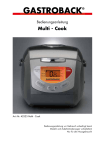


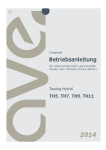
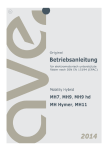
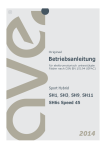
![[ Bedienungsanleitung ]](http://vs1.manualzilla.com/store/data/006735880_1-28334984de48ae2c5a8573c29f433271-150x150.png)
